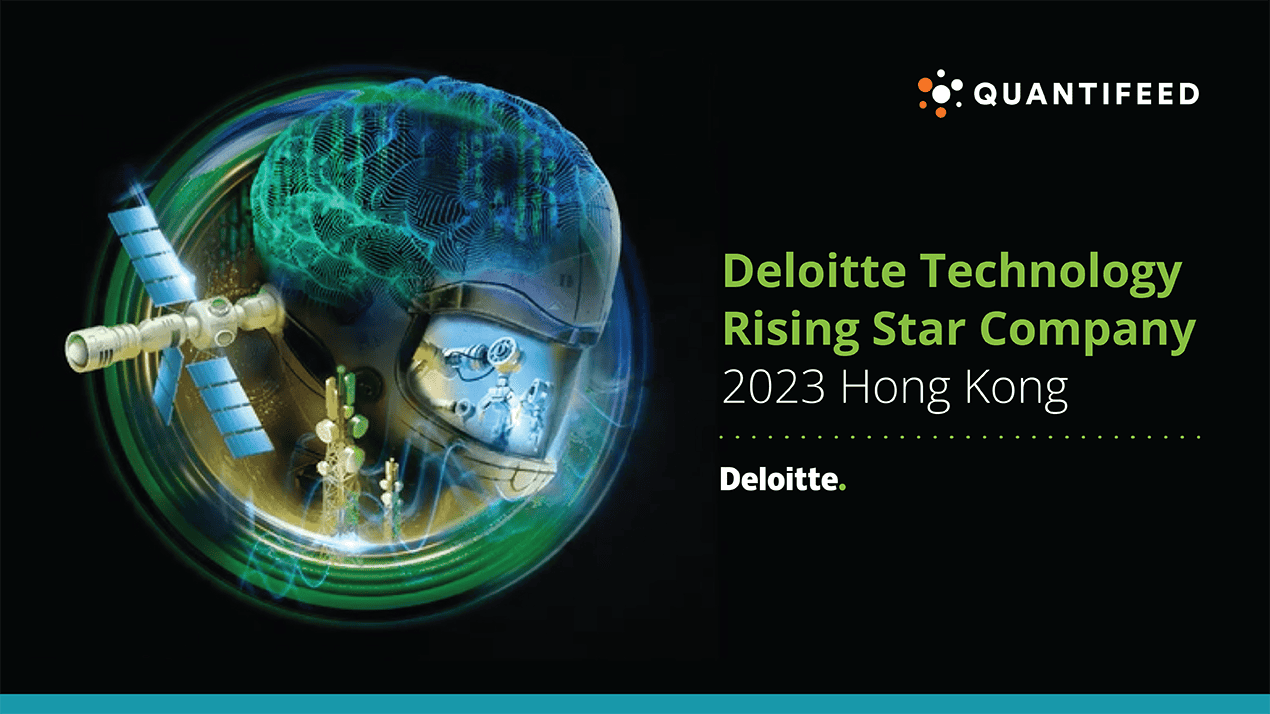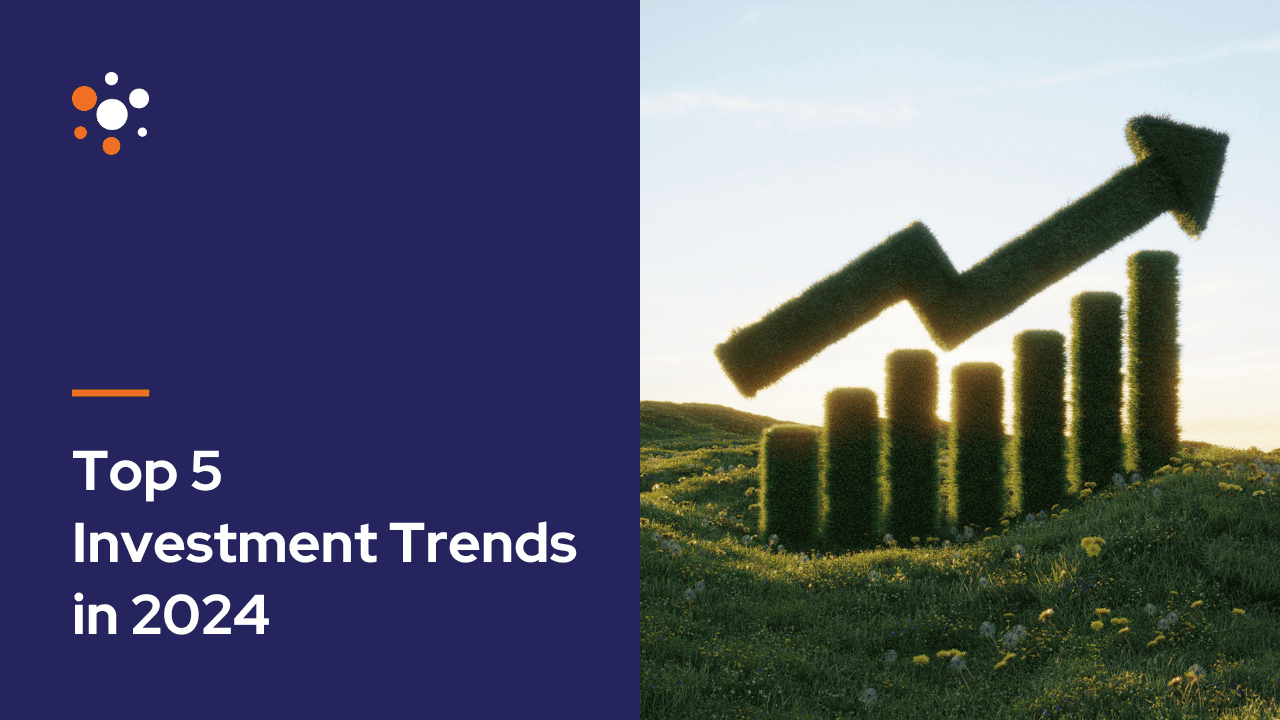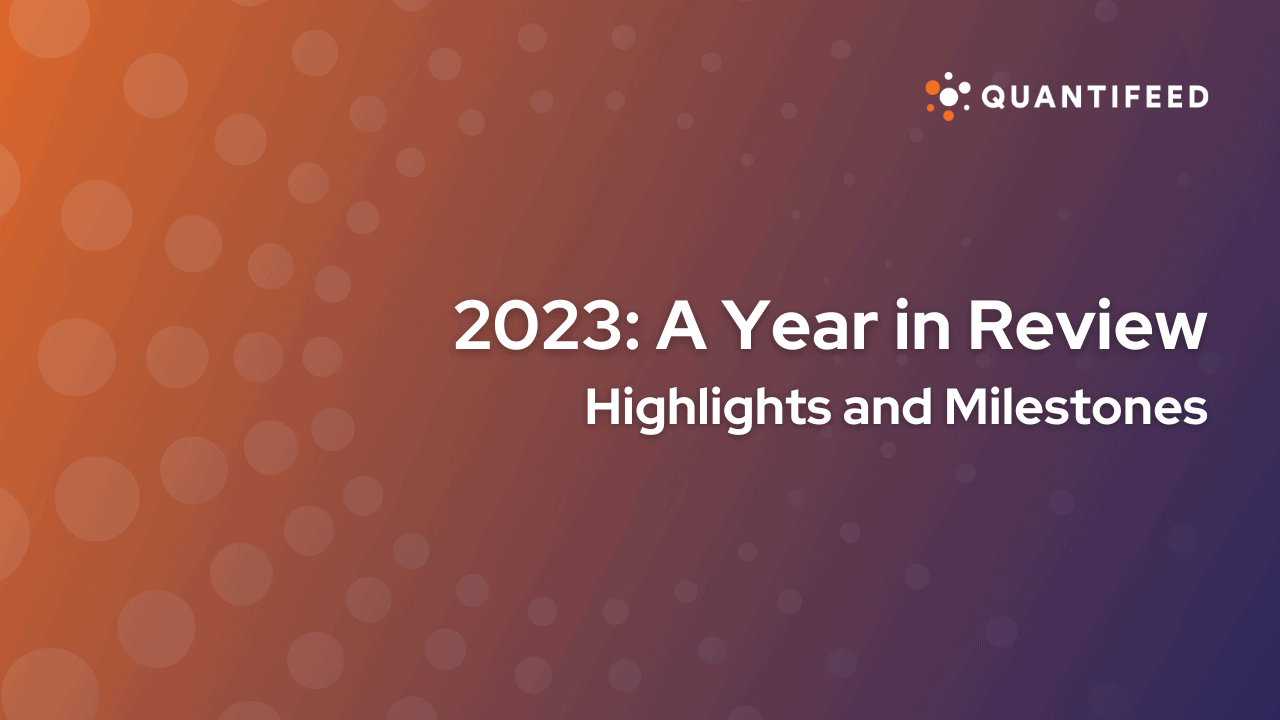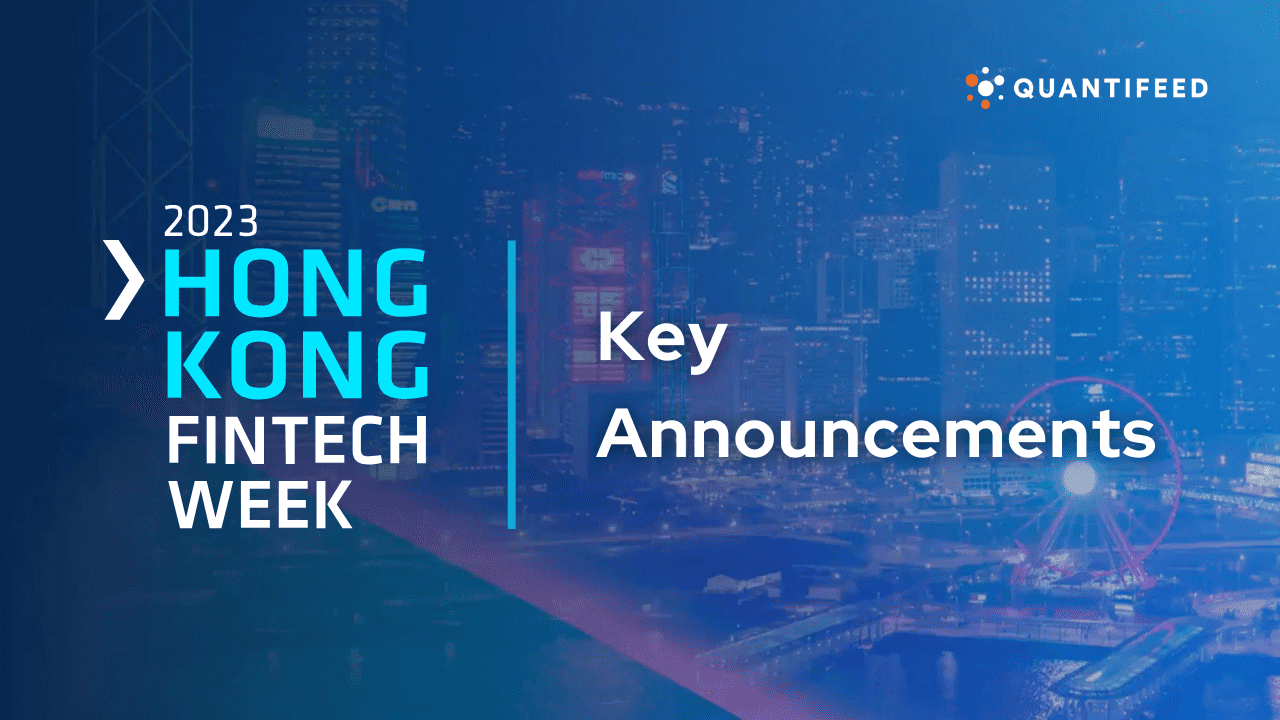
Top Cyber Security Threats for FinTech in 2024
In this article we will be exploring some of the top emerging or returning cyber security threats for the FinTech field, as well as best practice suggestions against them.

In this article we will be exploring some of the top emerging or returning cyber security threats for the FinTech field, as well as best practice suggestions against them.

The EMEA wealth management outlook for 2024 is a dynamic response to the convergence of technology, client expectations, and economic shifts.

The US market has a strong foundation in big data technology, with a projected growth rate of a remarkable 12% CAGR until 2030.

We are proud to announce that Quantifeed has been awarded the prestigious 2023 Deloitte Technology Rising Star Award.

As we step into 2024, several investment trends are shaping the market, offering both challenges and opportunities for investors.

As the year draws to a close, we reflect on a period filled with gratitude, innovation, and substantial growth. Read on to explore some of our notable highlights from this year.

The Quantifeed team participated in Singapore FinTech Week 2023 from November 15th to 17th. With over 62,000 attendees from 100+ countries, the event showcased major trends and announcements in FinTech. Read on for our summary

From sustainable finance to digital transformation, cross-border opportunities, and talent development, Hong Kong is cementing its status as a global FinTech hub.

We are pleased to introduce this month’s portfolio in Robotics US. Created in late 2016, this strategy focuses on US robotics opportunities, spanning industries like healthcare, consumer products, home applications, agriculture, logistics, and entertainment.
We use Cookies to enhance your online experience. By agreeing, you accept our Cookie Policy, Click 'Accept All Cookies' or 'Manage Cookies Settings' to choose specific preferences. You can update these settings anytime.

When you visit any web site, it may store or retrieve information on your browser, mostly in the form of cookies. Control your personal Cookie Services here.

Chief Technology Officer &
Co-Founder
Ross Milward leads Quantifeed’s technology and engineering efforts to deliver innovative digital wealth management solutions. Before co-founding Quantifeed, he spent more than 15 years in investment banking, holding senior positions in equity and equity derivatives technology.
His expertise is in developing and managing large-scale enterprise-level global trading and risk systems. A former managing director, Ross has worked for Bank of America Merrill Lynch and Deutsche Bank. He has held multiple global and regional leadership roles, most recently as head of equities technology in Asia. He has worked in Hong Kong, Sydney and London.
Ross holds a Bachelor’s degree in Computer Science with Honours and is a Fellow of the Securities Institute of Australia. He likes pushing his limits through long distance triathlon races.

Head of Sales and Business Development, North America
Toby Warner leads new client acquisition activities for North America. In his role, he closely collaborates with large financial institutions seeking market-leading fintech solutions to enhance their client offerings and improve the efficiency of their current asset management operations.
Toby has over 30 years of experience in the financial services industry. He has held various senior sales roles at Fidelity, ETRADE, and Morgan Stanley, where he has successfully partnered with many of the world’s largest global companies.

Head of Marketing & Communications
Rachel Liu leads Quantifeed’s marketing and communications initiatives. She is responsible for creating and accelerating the company’s marketing strategy and brand recognition across the region. Her expertise is in brand management and building global product campaigns. Prior to joining Quantifeed, Rachel built and executed marketing strategies at notable technology companies servicing business and retail sectors across Europe, US and Asia Pacific.
Rachel holds a MSc in Media and Communications from London School of Economics and Political Sciences and a Bachelor of Fine Arts from New York University.

Chief Commercial Officer
John Robson drives Quantifeed’s client partnerships. He works with financial institutions to assist them in developing their digital wealth management future. Based in Hong Kong for over 30 years, he has held regional leadership roles at JP Morgan, Nomura and Merrill Lynch managing teams which serviced the region’s consumer and private banks.
His career has been focused on the development of investment platforms and products. He has been instrumental in introducing significant product innovation to wealth management platforms in Hong Kong, London and Tokyo.

Chief Operating Officer &
Chief Financial Officer
Audrey Wong manages operations and financial affairs to deliver on Quantifeed’s business strategy. Audrey joined Quantifeed from Bank of America Merrill Lynch, where she was COO for the equities division in Asia Pacific. Audrey’s tenure at Merrill Lynch included senior assignments in Toronto and New York, before relocating to Hong Kong in 2006 to take a new role as the Finance Head of Equities Derivatives for APR.
Her responsibilities expanded to CFO of APAC Equities in 2011 and CFO for APAC Global Markets in 2013. Audrey holds a Bachelor of Business Administration from Brock University of Ontario. She is also a Chartered Professional Accountant of Ontario and Chartered Financial Analyst. Audrey enjoys biking and swimming with her two children.

Chief Sales Officer
Robert Rice leads Quantifeed’s sales strategy and works with clients to define and deliver digital wealth management solutions. Based in Hong Kong for over 15 years, Robert has held sales leadership roles in APAC and EMEA at London Stock Exchange Group (formerly Refinitiv), Fitch Solutions, OFX and SNL Financial, leading teams servicing wealth managers, asset managers and financial institutions.
His career is focused on brining innovative platforms, products and solutions to market helping clients meet their objectives. Robert is an appointed Mentor for the Hong Kong Fintech Week advising start-ups and market entrants on various topics and go to market initiatives.

Head of Pre-Sales
Conor has over 20 years’ experience working in the Japanese market leading sales and service teams in high-growth financial software vendor organisations. He is bilingual (fluent in Japanese and English), with strong technical and integration experience and a proven track record of meeting targets, overcoming challenges in real time, and delivering tangible results.
Conor is an expert presenter, negotiator, and business operations manager. He is able to forge strong relationships with both clients and partners and build consensus across multiple organisational levels. Conor has demonstrated capacity for leadership and project management. His previous work experience focuses on leading multinational, cross-functional teams in the provision of leading-edge, highly complex and high-value fintech business solutions. Conor has a Mechanical Engineering degree from University College Dublin.

Head of Delivery & Singapore Country Lead
Parul Srivastava leads Quantifeed’s Delivery function. She enables Quantifeed customers to successfully adopt and launch innovative digital wealth management solutions. Parul brings 18 years of strong experience in the financial services industry, her knowledge edges across the delivery lifecycle and wealth domain areas including AML, KYC, client onboarding and Payments. She is experienced in managing complex , high value enterprise level programs with leading Banks like SCB , BNPP, OCBC and Technology Service providers like Cognizant, BAE Systems , Fenergo. She has worked vastly for APAC and EMEA region deliveries primarily based out of Singapore.
Parul Holds a Master’s in Business Administration in Finance and Accounting and is Certified PMI- Project Management Professional, Scaled Agilist, Scrum Master(CSM) and Product owner (CSPO). Beyond work she is interested in Art and Travel.

Head of Product
Chetan leads Quantifeed’s product management capability and drives the implementation of features in our product that continuously solve digital wealth management problems for our clients.
Chetan started his career as a software engineer in the aerospace industry working across the entire software development lifecycle. Subsequently he worked in various roles helping large enterprises in Hong Kong solve business problems with process and technology solutions. His experience ranges across aviation, insurance, public sector services and consulting. He has lived and worked across multiple countries and enjoys travelling to new places, tasting new cuisines and occasionally writing his blogs.

Head of Core Engineering & Australia Country Lead
Lars Bischoff is a lead senior software engineer on Quantifeed’s back-end services, with a focus on trading and external interfaces.
Before joining Quantifeed, Lars had a number of leadership roles across major investment banks including Deutsche Bank, JP Morgan, UBS, and Citi. These roles included designing and implementing systems for Equities and Equity Derivatives Trading. Lars also held roles as country lead for Equities and Equity Derivatives Technology, as well as global lead for Equity Derivatives Trading.
As a former Executive Director in Deutsche Bank and JP Morgan, Lars has extensive experience in building local and global development teams. In this capacity, he also defined and realised the technology direction and innovative platforms in the Equity and Equity Derivatives space for these two organisations. Lars holds a Bachelor of Science degree in Computer Science, from Macquarie University, Sydney.

Head of Site Reliability Engineering
John leads the SRE team in Singapore and is responsible for the overall infrastructure and SDLC of Quantifeed’s technology platform, QEngine. He ensures the design, availability, and reliability meets the requirements of both our internal and external users. He has over 20 years’ experience in the banking industry, with a demonstrated history in transforming back-office technology and developing reliable engineering systems for large financial institutions.
Prior to joining Quantifeed, John held technical and leadership roles at Bank of America Merrill Lynch and Standard Chartered Bank. He holds a BSc degree in Artificial Intelligence from The University of Manchester in the United Kingdom. John moved to Singapore in 2008 and enjoys travelling with his family, football and scuba diving.

Head of Quantitative Engineering
Joy steers Quantifeed’s research and development in systematic investment strategies, portfolio construction and trade execution. Prior to joining Quantifeed, she worked as a quantitative analyst in asset management and proprietary trading firms.
She led development of trading strategies, including design,simulation and risk control, and research in market trend recognition and prediction. Joy earned her PhD in Operations Research from the University of Hong Kong, her MS in Statistics from Nan Kai University and her BS in Computational Mathematics from Dalian University of Technology.

Head of Web Engineering
Michael McDonald builds Quantifeed’s online wealth management web application in order to deliver a user-friendly and integrated experience. Michael has over 11 years of experience in web application development.
As Developer for Crossroads Hong Kong, he and his team set up the infrastructure for its donation and stock management application. As Developer at e-commerce company Synapse Connect in New Zealand, he and his team helped clients build mobile applications like prospersoftware.nz, providing him with a full-stack web development and DevOps skillset, servicing clients and back-office operations.
Michael holds a Bachelor degree in Electrical and Computing Engineering from University of Canterbury New Zealand. He moved to Hong Kong in 2014 and enjoys the outdoors sports such as hiking and cycling.

Sales Director, NA
Sharon Tang leads sales and business development activities in the North Asia region at Quantifeed. Based in Hong Kong, she works closely with financial institutions across the region to help them develop their digital asset management capabilities. She has over a decade of experience in the finance industry and previously held senior regional sales positions at Osttra (formerly part of IHS Markit) and FIS.
Sharon holds a Bachelor’s degree in Business Administration from the University of Science & Technology in Hong Kong and a Master’s degree in Corporate Communications from IE Business School in Spain.

Client Success Lead
Vincent Emond leads Quantifeed’s client success team, designing compelling business proposition and driving client experience to ensure they achieve their desired outcomes.
Vincent has 15 years of experience spearheading innovative digital products in banking, insurance, and tech industries. Before joining Quantifeed, Vincent led product development and management for several HSBC digital platforms, including their flagship retail banking app in Hong Kong. He was also AXA’s Head of Digital Centre of Excellence, where he helped launch AXA’s first blockchain-powered insurance product. As a technically proficient digital consultant gifted in interpersonal relationships, one of Vincent’s most valuable skills is in bridging customer needs with complex technological solutions.
Vincent holds a Bachelor’s degree in Business and Marketing and a Master of Business in E-Commerce. Outside of work, he can be found climbing steep hills on his road bike as he strives towards his goal of breaking local Strava cycling records one segment at a time.

Commercial and Business Development Lead
Matt Johnson is responsible for leading the commercial and business development efforts for EMEA, where he drives sales and partnership initiatives. With over 30 years of experience in Global Markets, Asset Management, and Financial Technology Sales, Matt brings a wealth of expertise to his role.
Throughout his career, Matt has demonstrated his ability to effectively manage European and global equity derivatives and exchange traded product sales teams, as well as holding executive committee and broader management positions. His entrepreneurial spirit and investment acumen have further motivated him to invest in multiple start-ups and Fintech companies.

Sales Director, South East Asia
Deepshikha Chaudhary drives sales initiatives for Quantifeed Singapore. She is responsible for building and growing the company’s presence in Southeast Asia. Prior to Quantifeed, Deepshikha worked with various financial technology providers leading business expansion in the region. She also has hands-on experience in the product development of a cloud-based trading and execution platform for Asia and Europe. Deepshikha has over a decade of experience in the finance industry.
Deepshikha holds a Bachelor of Technology in Computer Science and a Masters of Business Administration in Finance from Singapore Management University. To get her going, she likes to run, practice yoga and go surfing.

最高技術責任者・創業者
Ross Milwardは、革新的なデジタル資産管理ソリューションを提供するQuantifeedのテクノロジーとエンジニアリングを主導しています。Quantifeedを共同設立する以前は、15年以上投資銀行業務に従事し、株式および株式デリバティブ技術の上級職を歴任してきました。
彼の専門分野は、大企業のグローバル取引およびリスクシステムの開発と管理です。Rossは元マネージングディレクターで、バンク・オブ・アメリカ・メリルリンチやドイツ銀行で働いた経験があります。グローバルおよび地域のリーダーとして複数の役割を果たしており、アジアの株式テクノロジーの責任者を務めていました。また香港、シドニー、ロンドンの各拠点での業務経験があります。
Rossは優秀な成績でコンピュータサイエンスの学士号を取得し、オーストラリア証券研究所の相談役でもあります。彼は長距離のトライアスロンレースで限界に挑戦することが好きです。

代表執行役社長・創業者
Alex Ypsilantiはデジタル資産管理の課題を解決するQuantifeedのミッションをCEOとして担っています。
Quantifeedを共同設立する以前は、投資銀行の調査アナリストとして15年間働いていました。彼の仕事は、投資家がリスク調整後のリターンを改善し、より広範な市場戦略とリスクプレミアムにアクセスできるようにすることでした。機関投資家にとってトップランクの調査アナリストであったAlexは、欧州ETF市場の成長、ヘッジファンドの複製、ポートフォリオにおけるボラティリティ商品の利用において主導的な役割を果たしました。
モルガン・スタンレーとバンク・オブ・アメリカ・メリルリンチの元マネージングディレクターであるAlexは、ロンドン、東京、香港の各拠点でデリバティブと定量ストラテジストのチームを率いてきました。
Alexはロンドン大学インペリアルカレッジで情報システム工学の学士号と修士号、数理ファイナンスの博士号を取得しています。

プリセールス責任者
Conor は、急成長している金融ソフトウェア ベンダー組織の日本市場をリードする販売およびサービス チームで 20 年以上の経験を持っています。彼はバイリンガル (日本語と英語に堪能) であり、強力な技術と統合の経験があり、目標を達成し、リアルタイムで課題を克服し、具体的な結果をもたらした実績があります。 Conor は、専門のプレゼンター、交渉担当者、およびビジネス オペレーション マネージャーです。彼はクライアントとパートナーの両方と強力な関係を築き、複数の組織レベルでコンセンサスを構築することができます。
Conor は、リーダーシップとプロジェクト管理の能力を実証してきました。彼の以前の職務経験は、最先端の非常に複雑で価値の高いフィンテック ビジネス ソリューションの提供において、多国籍のクロスファンクショナル チームを率いることに重点を置いていました。コナーはユニバーシティ カレッジ ダブリンで機械工学の学位を取得しています。

日本における代表
プログラムマネージャー
三木健太郎は、Quantifeedのソリューションを日本市場に届けるためのデリバリーチームのプロダクトオーナーです。
三木は、ゴールドマン・サックス、シティ・グループ、リーマン・ブラザーズなどのグローバル投資銀行のテクノロジー部門で、開発者、ビジネスアナリスト、プロジェクト・マネージャーとして20年以上勤務してきました。
彼の専門分野は、フロントからバックまで金融商品をよく理解したシステム、ビジネス、運用フローの設計です。
早稲田大学を卒業し、スノーボードとブラジリアン柔術を趣味としています。

Head of EMEA
Geoff Langham manages the Quantifeed EMEA team based in London and co-founder of Alpima. He is responsible for implementing the company’s infrastructure and its strategic direction. He has worked closely with all teams to successfully deliver solutions to its global clients and partners.
A twenty seven year veteran in the Finance industry, Geoff brings a wealth of experience from a trading and management perspective. Raised and educated in Canada at Queen’s University, he relocated to London to complete his MSc in Financial Economics. He began his career at JP Morgan trading FX/Rates following onto Morgan Stanley on the buy and sell sides as an equity trader. For the past 15 years, Geoff has held Board positions and COO roles at several fast growing financial companies.
In his spare time Geoff is a keen tennis player, powder skier, aspring chef and father to his three daughters.

Head of Product, EMEA
Karen Tierney leads Quantifeed EMEA’s product team. She works closely with all teams across the organisation to evolve the product offering. She is responsible for ensuring the platform-wide strategy is aligned to customer’s needs, and our product build is prioritised, planned and executed effectively.
Trained as an Operations Research and Statistics Engineer with a Masters in Management, Karen brings a wealth of experience in product and programme management having delivered multifaceted client, regulatory and technology change projects. She joined Quantifeed from DWS and previously worked at RBS, Barclays, Deloitte and The National Bank of New Zealand.
Originally from New Zealand, Karen loves the great outdoors and is a keen swimmer. She lives in London with her husband and 3 young children.

Head of Client Success, EMEA
Ananth leads the Client Success team at Quantifeed EMEA. Ananth has a wealth of experience in finance and operations with a track-record of building and managing successful client facing teams in global organisations. His team is responsible for onboarding and closely supporting Quantifeed’s portfolio of clients. He leads various aspects of client relationships as well as client training, product adoption and retention.
Prior to Quantifeed, Ananth worked at Morgan Stanley and was principally responsible for building and scaling the sales-trading desk for structured products across Morgan Stanley’s clients base in EMEA.
His time outside of work is mainly spent with his wife and two young children. He is passionate about travel, cuisine, sport, in particular football and scuba diving.

Head of Pre-sales, EMEA
Dorothée Servant leads as Head of Presales at Quantifeed EMEA. She works closely with the product and engineering teams as well as on the client side to ensure the smooth delivery of high-quality client solutions. Her team is responsible for managing the complete life cycle from the initial specification phase to the final delivery, including the planning, execution, and testing phases.
Before joining Quantifeed, Dorothée worked as project owner at THALES, a French multinational company, interacting with all the Business Units in Europe. She holds an MBA from IESE Business School, and a master’s degree in civil engineering from l’Ecole Nationale Supérieure des Mines de Nancy.
Originally from France, born in Spain and growing up in South America, Dorothée enjoys travelling and discovering new parts of the world.

Head of Finance, EMEA
Claire Percy heads up the EMEA finance function overseeing financial processes and reporting. She works closely with the wider team to ensure day-to-day business efficiencies.
Working across a variety of different industries including management consultancy, outsourcing, manufacturing, digital media, Claire has gained valuable commercial and operational experience to deliver high quality reporting and analysis to aid better information and decision making.
In her free time, Claire balances the chaos of family life with her love of outdoor adventuring; running, hiking and wild-water swimming.

Head of Quantitative Solutions
Alastair Smith spearheads Quantifeed EMEA’s Quantitative Solutions team. Alastair and his team’s extensive knowledge of quant finance and trading strategies allows Quantifeed to develop cutting edge investment products to effectively serve its growing portfolio of global clients and partners.
Prior to joining Quantifeed, Alastair worked as an academic at Cambridge University, where he researched moment problems and stochastic solutions to integro-partial differential equations in very large numbers of dimensions. He holds a doctorate in stochastic modelling and a degree in mathematics both from the University of Cambridge.
Outside of work, Alastair has keen interests in travel, rowing, cycling, chess and cryptoassets.

Head of Application Engineering
Tom Barnes oversees the Application Engineering team at Quantifeed EMEA. He is responsible for technology and platform architecture across the organisation, optimising the scale and performance at which the platform operates.
Tom has twenty years of tech experience. In his career to date he has architected, delivered and scaled systems across a range of industries, built on a variety of technology stacks. Immediately prior to joining Quantifeed, Tom was a part of an award-winning startup, designing and delivering location-based services used by police and armed forces across Europe.
When he’s not studying for his MBA, he can usually be found walking, running or cycling around the forest in Epping, where he lives with his partner and their three children.

Program Manager
Japan Country Lead
Kentaro Miki Heads up the delivery team in Japan to bring Quantifeed’s solution to the local market.
Kentaro has been working at Technology division at Global Investment Banks such as Goldman Sachs, Citi Group, Lehman Brothers etc. as developer, business analyst and project manager over 20 years.
His expertise is designing system, business and operational flow with good understanding of financial products from Front to Back.
He graduated Waseda University in Tokyo, Japan and he likes snowboarding and Brazilian Jiu-Jitsu.

Chief Executive Officer &
Co-Founder
Alex Ypsilanti spearheads Quantifeed’s mission to solve the challenges of digital wealth management.
Before co-founding Quantifeed, he spent fifteen years as an investment banking research analyst. His work enabled investors to improve their risk-adjusted returns and to gain access to a wider range of market strategies and risk premia. Alex, a top ranked analyst by Institutional Investor, had a leading role in the growth of the European ETF market, hedge fund replication and the use of volatility products in portfolios.
A former managing director for Morgan Stanley and Bank of America Merrill Lynch, Alex has built and led teams of derivatives and quantitative strategists in London, Tokyo and Hong Kong.
Alex holds Bachelors and Masters degrees in Information Systems Engineering and a PhD in Mathematical Finance from Imperial College, University of London.